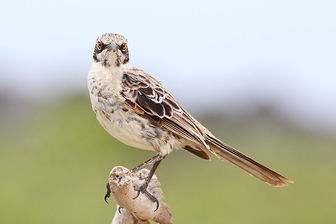Hood Mockingbird
The Hood Mockingbird or Española Mockingbird is a species of bird in the Mimidae family. It is endemic to Española Island in the Galápagos Islands, Ecuador and is a member of the Galápagos mockingbirds, four closely related species endemic to the island chain. It is found in dry forests and is omnivorous, though it primarily is a carnivore or scavenger. The species has a highly territorial social structure and has no fear of humans.

The Hood Mockingbird is classified as Vulnerable (VU), considered to be facing a high risk of extinction in the wild.
The Hood Mockingbird (Nesomimus macdonaldi) or Española Mockingbird is a species of bird in the Mimidae family. It is endemic to Española Island in the Galápagos Islands, Ecuador and is a member of the Galápagos mockingbirds, four closely related species endemic to the island chain. It is found in dry forests and is omnivorous, though it primarily is a carnivore or scavenger. The species has a highly territorial social structure and has no fear of humans. More
Hood mockingbird, in contrast to species that live on other islands without such colonies, has developed some unique and bizarre feeding habits. The birds will eat blood from animals' fresh wounds or eat congealed blood from the sand. Engorged ticks and skin are picked from live iguanas. More
Videos and images Hood mockingbird with insects in beak The inquisitive, blood-drinking hood mockingbird is the largest of all the mockingbirds in the Galápagos Islands. It has a very long bill that curves downwards, and yellowish-brown eyes surrounded by a dark patch. The feathers of the upperparts ... More
A Hood Mockingbird picking on a crab in the white sand - Hood Mockingbird: Scientific Name: Nesomimus macdonaldi share to Facebook Hood Mockingbird, feeding. More
The Hood Mockingbird's fearlessness and willingness to eat just about anything are adaptations which have helped it to survive in the Galapagos RELATED VIDEO Real 28K March 4, 1999 Web posted at: 4:23 p.m. EST (2123 GMT) By Christina Allen Kersplash! I jumped off the dingy ("panga") to make my first wet landing onto Gardner Beach. Seawater soaked my backpack, but cooled my sunburned skin. More
The hood mockingbird is territorial, with seven to ten adults per territorial group, but often only one breeding pair (2). The hood mockingbird is a co-operative breeder, meaning that non-breeders act as helpers at nests in their group's territory, and some breeders help raise nestlings in nests other than their own (3). The cup-shaped nest, made of twigs and lined with finer plant material, is often placed in a cactus. More
A Hood Mockingbird picking on a crab in the white sand nature stock photography travel Stock photos / pictures per page in Hood Mockingbird: Please use the search (powered by Google) to find what you looking for - give it a try - you will be surprised how well it works! * stock travel photography feed * stumble stock More
The Hood Mockingbird has a much longer, more curved beak than the Galapagos Mockingbirds. More
The Hood Mockingbird (Nesomimus macdonaldi) is endemic to Hood Island in the Galapagos. The digital shot on the left was taken there in July, 2003, with a Canon EOS 10D and an EF 70-200 mm F/2.8 L IS lens. These birds are remarkably tame and even land on tourists on a regular basis. The next 5 images were taken on Hood Island in July, 2007, with a Canon EOS 1D Mark III and EF 100-400mm F/4.5-5.6 L IS lens. More
The Hood mockingbird has a much longer, more curved beak than the Galapagos mockingbird 's. There is also a pronounced behavior difference. The mockingbirds, like most Galapagos species, are quite unafraid of people and very curious, but the Hood mockingbird is extremely aggressive. It is not uncommon for them to land on a visitor's head and they will explore any unknown object, always looking for food or drink. More
Physical characteristics: Hood mockingbirds are dull white on the chest and belly and streaked or spotted gray to brown coloring on the top. The dark wing feathers appear edged off-white. They may also have darker spots on the chest. The Hood mockingbird sports a black streak across its yellow-to-brown eyes, and has a black bill and legs. Geographic range: The Hood mockingbird is found primarily on a small island in the Galápagos known as Hood Island (also known as Espantildeola). More
The Hood Mockingbird is also endemic to the island. These brazen birds have no fear of man and frequently land on visitors heads and shoulders searching for food. The Hood Mockingbird is slightly larger than other mockingbirds found in the Galapagos; its beak is longer and has a more curved shape. The Hood Mockingbird is the only carnivorous one of the species feeding on a variety of insects, turtle hatchlings and sea lion placentas. More
Hood Mockingbird Hooded Crow Hooded Oriole Hooded Siskin Hooded Vulture Hooded Warbler Hoopoe Hornbill Hornby's Storm-petrel Horned Puffin House Bunting House Crow House Finch House Martin House Sparrow Hudsonian Godwit Humboldt Penguin Hume’s Leaf Warbler Hyacinth Macaw Iago Sparrow Icterine Warbler Imperial Woodpecker Inca Dove Inca Tern Indian Pitta Indian Pond Heron Indian Roller Indian Silverbill Indian Skimmer Indian White-rumped Vulture Indigo Bunting Inland Dotterel Isabelline Shrike Isisbill Ivory Gull Ivory-billed Woodpecker Jabiru Jack Snipe Jackdaw Jambu Fruit Dove James Flamingo Japanese Bush More
Stock photos of: Hood Mockingbird on rock - Stock image 1830132 = WEB $ 55.00 PRINT $ 300.00 Hood Mockingbird on rock Similar Stock Images Loading... More

